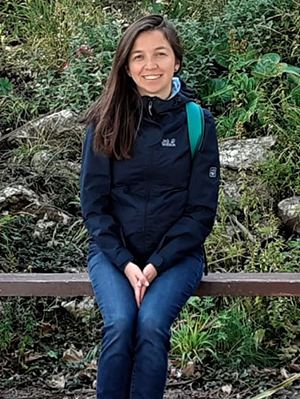
Dr. Mariana Schuster
|

Dr. Jonathan
Jones (Photo courtesy JIC Photography) |
Dr. Mariana Schuster
Dr. Mariana Schuster is a post-doctoral researcher in the Plant Chemetics laboratory at the University of Oxford. Her research currently focuses in unravelling the role of immune cysteine proteases of tomato against the devastating pathogen Phytophthora infestans.
Dr.
Jonathan Jones
Dr. Jonathan Jones is a professor of biology at the University of East
Anglia, Norwich, UK, and a group leader at The Sainsbury Laboratory (TSL) in Norwich. His
group studies the defense mechanisms that plants use to resist pathogen attack
and the strategies that pathogens deploy to overcome the plant immune system.
Jonathan has made landmark contributions to the field of plant immunity, and
his work has been recognized with honors, including an EMBO
membership, a Fellowship of
the Royal Society, and an International
Membership in the U.S. National Academy of Sciences. Jonathan was recently awarded an Honorary
Membership in the British Society of Plant Pathology. On occasion of the award, I had the pleasure of
interviewing him and discussing his exceptional academic career, the challenges
of living as an academic and bringing one's science to public use, and getting
a glimpse of the man behind the scientist.
Jonathan recognized that he wanted to be a scientist
from early on. However, he says he is an "accidental plant pathologist."
Initially interested in physics and chemistry, but always motivated by research
on the mechanisms that govern life, Jonathan started his Ph.D. program in the
early years of molecular genetics and working with plant DNA. He and his team
then needed to acquire protein biochemistry skills to understand the mechanisms
by which the genes revealed in their cloning contributed to a phenotype (1). Looking back, he highlights the benefits of the
lifestyle of a scientist: "typically, in life, the more you think about
yourself, the unhappier you are. When you are doing science, you become very
preoccupied with thinking about your research problem, which is much more fun
than thinking about yourself."
It is no secret that
the career path to become an academic has changed since Jonathan started out.
He acknowledges that "now it is much tougher than back then." But, as
in the past, the key go/no-go moment to secure an academic post is when people
are applying for a faculty position. Looking back, he admits that after his Ph.D.
degree he "caught the wave of plant molecular genetics, where I was one of
a leading group of scientists who had the skills to chase down interesting
genes to begin to figure out their function" and that it was the "skill
he brought to bear on the problem." The skill was important back then and
is still relevant, but now most labs have these skills: "To get a job you
have to present yourself as someone who is particularly good at something, who
can bring those skills to tackle a problem—and it has to be an important and
interesting problem—where no one has applied those skills and methods before."
In addition, what Jonathan now looks for in applicants for group leader
positions is a unique, original, and independent-minded engagement with the
biological problem; a mature knowledge of the field that allows the applicant
to recognize a relevant research question; and a size and outlook of the
project that lies within "that sweet spot of what is ambitious yet
feasible" and is also "a project that has legs."
In his case, Jonathan
became a group leader and entered the field of plant pathology by applying his
skills in plant molecular genetics to the identification of the then-enigmatic Resistance (R) genes. R genes were
known to confer disease resistance against pathogens. Using transposon tagging,
his group was able to identify Cf-9, a gene that confers tomato resistance against the
fungal pathogen Cladosporium
fulvum (2). "It was very satisfying to develop a lethal
selection that enabled almost effortless recovery of dozens of mutants in Cf-9," Jonathan
commented.
Cf-9 encodes a cell-surface immune receptor containing
leucine-rich repeats—the first such receptor to be discovered. Immune receptors
are key proteins that detect molecules from invading pathogens and then
initiate the signaling that ultimately leads to defense responses. Jonathan's
group identified many such receptors and soon started researching their
function.
I have listed only a
couple examples of the fundamental discoveries that Jonathan's group has made
in our understanding of the proteins that confer resistance to pathogen attack.
In fact, when asked which contribution to plant
pathology he is proudest of, he answers: "I could mention a few." Hunting for the
mechanism of action of receptor-like proteins (RLPs), he devised a theoretical framework for how
receptors could be activated, now known as the guard hypothesis (3). "This
was my first theoretical contribution to be
later validated experimentally in a nice collaboration with the group of Pierre de Wit,"
he said. He referred to work on Cf-2, another immune receptor from tomato that monitors
(guards) the activity status of tomato cysteine protease Rcr3, an important
component of the plant's defense repertoire. Rcr3 is targeted by the pathogen
effector Avr2, a cysteine protease inhibitor. Once the pathogen tries to disarm
the plant by inactivating Rcr3, it falls into the trap of the guard mechanism that
ends in a strong Cf-2-dependent
defense response (4). He's also proud to have contributed to the success of
TSL, alongside his superb set of colleagues who continue to do pioneering
science at TSL, and of the success of the alumni who are former students or
postdocs from his lab, such as Tina Romeis, Martin Parniske, Brande Wulff, and
Cyril Zipfel. He's also hugely grateful to all the students and
postdocs who've contributed to the success of his lab over the last 32 years,
and to David Sainsbury's Gatsby
Foundation for their sustained
and generous funding of TSL.
Inspired by the work
of the Brian Staskawicz lab that showed that a pepper immune receptor can confer
disease resistance in tomato (5), Jonathan decided to open an applied research
stream in his group that aims to tackle crop losses due to diseases. The idea
is elegant and powerful: generate pathogen-resistant crop varieties by
introducing immune receptors into plants that lack them. When asked about how
that experience compares to life as an academic, he starts by stressing that
fundamental discoveries in science are the major source of solutions for "real
life problems," and that although he is satisfied with the balance between
applied and basic research in his group, he is conscious that "you cannot
do everything, so any time I spend in applied research, is time I do not spend
making fundamental discoveries, although work with an applied intent can reveal
new and interesting scientific problems."
Some examples of
resistant plant varieties developed with contributions from Jonathan's group
can be found in the June 2016 edition of Nature Biotechnology: soybean resistant to
Asian soybean rust (6), potato resistant to late blight (7), and wheat
resistant to stem rust (8). Two of these three papers were dependent on RenSeq
(8), the sequence capture method for R gene cloning developed in his lab.
Jonathan is happy to have contributed to applied plant science but acknowledges
that he did not predict, and thus underestimated, the fact that people would
find problems in the solutions he provided. He finds the need to work around
these problems frustrating, but acknowledges that even scientists must have
faith and hopes that his solutions will be implemented eventually.
Jonathan is a happy
husband, father, and proud grandfather of four: "two 2‑year olds, one 5‑year
old, and one 8‑year old. Seeing them develop and grow is a great source of
happiness!" On work–life balance and family, he points out that "it's
hard enough to get your own life right, let alone anybody else's." He
highlights his appreciation for his illustrious partner Professor
Dame Caroline Dean. Their family features in the book Mothers in
Science.
When asked about his
passion aside from science and family, Jonathan told me that he likes to sail
on the weekends and that he owns a sailing boat called "zigzagzig," which is both the
name of what one must do to take a sailboat upwind and of the model describing
the immune system for which he is famous (8). "The Zig-zag-zig model was proposed to bring together two schools of
thought: the geneticists investigating gene-for-gene interactions, and the
biochemists who added elicitors to cell cultures and defined what happens."
According to this model, plants use cell-surface receptors to recognize the
presence of a pathogen and mount an immune response termed
pattern-triggered-immunity (PTI). Adapted pathogens use effectors to inactivate
PTI and cause disease (effector-triggered-susceptibility [ETS]). In turn,
resistant plants deploy specialized receptors, generally intracellular, to
detect these effectors and mount a stronger defense response termed
effector-triggered-immunity (ETI).
As to what is Jonathan up to today, on April 1 (not a
joke) of this year, his group published a new paper in
which they further explain the relation between PTI and ETI (10). This was independently
verified by another lab's report published in the same issue of Nature. Beforehand,
the nature of ETI was rarely studied in the absence of PTI. "These papers show that ETI replenishes and
restores PTI, not only helping us better understand the dynamics of the plant
immune system but also why R gene stacking
for disease resistance works so well. It's been very satisfying to see how the
basic and applied science in my lab has (dare I say?) mutually potentiated."
References
From physics
and chemistry to plant biology. Plant Physiology (nih.gov)
Isolation
of the tomato Cf-9
gene for resistance to Cladosporium
fulvum by transposon tagging. Science (sciencemag.org)
Plant
pathogens and integrated defence responses to infection. Nature
(nature.com)
Cladosporium
Avr2 inhibits tomato Rcr3 protease required for Cf-2-dependent disease resistance. Science
(sciencemag.org)
Expression of the Bs2 pepper gene
confers resistance to bacterial spot disease in tomato. PNAS (pnas.org)
A pigeonpea
gene confers resistance to Asian soybean rust in soybean. Nature Biotechnology
(nature.com)
Accelerated
cloning of a potato late blight-resistance gene using RenSeq and SMRT
sequencing. Nature Biotechnology (nature.com)
Rapid cloning
of disease-resistance genes in plants using mutagenesis and sequence capture.
Nature Biotechnology (nature.com)
The plant
immune system. Nature (nature.com)
Mutual potentiation of plant immunity
by cell-surface and intracellular receptors. Nature (nature.com)
